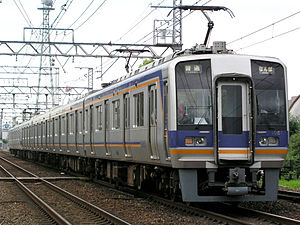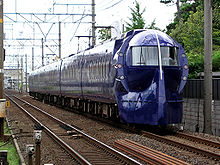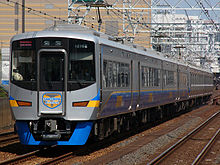- Nankai Main Line
-
Nankai Main Line 
Nankai 1000 series EMU on local serviceOperation Operator(s) Nankai Electric Railway Co., Ltd. Technical Track gauge 1,067 mm (3 ft 6 in) Electrification 1,500 V DC, overhead line Route diagram Legend


0.2 Namba -1980 
0.0 Namba 1980- 





0.9 Imamiyaebisu 


1.4 Shin-Imamiya 


2.0 Haginochaya 




Tennōji Branch Line 





3.0 Tengachaya 





 "Shiomibashi Line"
"Shiomibashi Line"


(part of Kōya Line) 


3.9 Kishinosato-Tamade 


Tamade abandoned in 1993 consolidation to Kishinosato-Tamade Station 
Kōya Line 

5.1 Kohama 
Hankai Tramway: Uemachi Line  ,
, 
 Hankai Line
Hankai Line




 Sumiyoshikōen/
Sumiyoshikōen/
 Sumiyoshi-Toriimae
Sumiyoshi-Toriimae




5.7 Sumiyoshitaisha 


Suminoe Depot 


6.7 Suminoe 
Yamatogawa (first) abandoned in 1888 
Yamato River 
Yamatogawa (second) 1889-1917 
8.2 Shichidō 


Sakai (first) -1955 


9.8 Sakai (third) 1985- 


Tate River 


Sakai (second) 1955-1985 




Ohama Branch Line (Ryujin) 


Ryujin abandoned in 1955 consolidation to Sakai Station 



Ohama 
11.2 Minato 
12.7 Ishizugawa 
Ishizu River 
13.8 Suwanomori 


 Hankai Line
Hankai Line


14.8 Hamaderakōen  Hamadera-eki-mae
Hamadera-eki-mae
JR West: Hanwa Line ("Hagoromo Branch Line") 



15.5 Hagoromo  Higashi-Hagoromo
Higashi-Hagoromo
 Takashinohama Line
Takashinohama Line
16.6 Takashinohama -1918 
17.4 Takaishi 
18.5 Kita-Sukematsu 
19.4 Matsunohama 
20.4 Izumiōtsu 
Otsu River 
22.3 Tadaoka 
23.7 Haruki 
Haruki River 
26.1 Izumi-ōmiya 

25.0 Kishiwada 

Tsuda River 
26.9 Takojizō 


28.6 Kaizuka 


Mizuma Railway: Mizuma Line 


30.4 Nishikinohama 

31.3 Tsuruhara 
32.4 Iharanosato 
Sano River 

34.0 Izumisano 


 Airport Line
Airport Line


JR West:  Kansai Airport Line
Kansai Airport Line



35.9 Rinkū Town 


Kansai Airport Bridge 




42.8 Kansai Airport Kansai Airport 
36.1 Hagurazaki 





Hagurazaki Depot 
37.4 Yoshiminosato 

38.8 Okadaura 
40.6 Tarui 

43.1 Ozaki 
44.6 Tottorinoshō 
46.6 Hakotsukuri 
50.2 Tannowa 
51.9 Misaki-kōen 
 Tanagawa Line
Tanagawa Line
Fuke abandoned in 1958 
56.3 Kyōshi 
↑Osaka Prefecture 
Kyoshi Tunnel 
↓Wakayama Prefecture 
Wakayama-Daigaku-mae Scheduled to open in 2012 


Kada 


 Kada Line
Kada Line
61.6 Kinokawa 
62.5 Wakayama-kitaguchi -1903 
Kinokawa River 


JR West: Kisei Main Line 





Wakayama Depot 




64.2 Wakayamashi 




Wakayama Tram Line (Kainan Line) 




Kitajima Branch Line 
 Wakayamakō Line
Wakayamakō Line


67.0 Wakayamakō 





Details of Namba area 





Subway: 
 Yotsubashi Line (Y15)
Yotsubashi Line (Y15)





Subway: 
 Midōsuji Line (M20)
Midōsuji Line (M20)





Subway:  Sennichimae Line
Sennichimae Line (S16)
(S16)





Kintetsu: Namba Line (Osaka Namba) 





Hanshin: Hanshin Namba Line (Osaka Namba) 





Namba 











Subway: 
 Sakaisuji Line
Sakaisuji Line





 Subway: Daikokuchō
Subway: Daikokuchō





Imamiyaenisu 





 Hankai Tramway: Ebisuchō
Hankai Tramway: Ebisuchō





Hankai:  Hankai Line
Hankai Line





JR West: Osaka Loop Line, Kansai Main Line (Yamatoji Line) 



Shin-Imamiya 





/Hankai: Minami-Kasumichō 





Subway:  Midōsuji Line
Midōsuji Line (M22)
(M22)





Subway: Dōbutsuen-mae 





Subway: 
 Sakaisuji Line (K19)
Sakaisuji Line (K19)





Haginochaya Hankai: Imaike 















Tengachaya 

Nankai Line (left)/Koya Line (right) The Nankai Main Line (南海本線 Nankai Honsen) is one of the two main railway lines of Japanese private railway company Nankai Electric Railway, together with Kōya Line. The route is from Namba Station in south downtown of Osaka to Wakayamashi Station in Wakayama via Sakai, Kishiwada, Izumisano and Misaki municipalities. The proper name is with the company's name, "the Nankai Main Line", not simply "the Main Line" often seen in other Japanese private railways. Lines of the Nankai Main Lane and the connecting lines excluded the Kōya Line and the Airport Line are named generically "the Nankai Line (南海線 Nankai Sen)". The line is shown with a pictogram of waves, or distinguished with blue from conifer or green Kōya Line.
Contents
Descriptions
- Line length: 64.2 km
- Track: quadruple from Namba to Suminoe (to Kishinosato-Tamade, eastern two tracks are for Kōya Line exclusively), double from Suminoe to Wakayamashi
History
One of the oldest private railway lines still existing, the Nankai Main Line was opened in 1885 by Hankai Railway (阪堺鉄道 Hankai Tetsudō) (separate from the present-day Hankai Tramway) between Namba and later abandoned Yamatogawa stations with 838mm gauge and steam motive power. Extension was made in 1888 to Sakai. In 1897 the then separate Nankai Railway opened between Sakai and Sano (present-day Izumisano). In 1897 Hankai regauged, in 1898 they merged with Nankai Railway. The present stretch was completed in 1903 to Wakayamashi Station. Electrification was begun in 1907 on the section from Namba to Hamaderakōen, and was completed in 1911.
Express and rapid service
Nankai and Kintetsu are the only two operators that offers charged Limited Express trains in private railways in Kansai.
- Limited Express Southern (特急サザン Tokkyū "Sazan") (LE)
- Partly charged for seat reservation, between Namba and Wakayamashi (or Wakayamakō) as the trains connecting to the Shikoku region.
- Airport Limited Express rapi:t (空港特急ラピート Kūkō Tokkyū "Rapīto") (ALE)
- Named rapi:t. Charged. operated between Namba and Kansai Airport, rapi:t α trains stop at only stations marked with S, and rapi:t β trains at stations marked with S and S*. Since Kansai International Airport opened in 1994. Exclusively with 50000 series 6 car formation.
- Limited Express (特急 Tokkyū) (LE)
- Day time, between Namba and Wakayamashi. Stops are the same as the Southern. No seat reservations.
- Express (急行Kyūkō) (Ex)
- Longest operation between Namba and Wakayamakō, passes Haruki Station. Before 10 a.m., after 4 p.m. on weekdays, early in morning on Saturdays, Sundays, Holidays, and up Express trains in the early morning and midnight. Half through to the Wakayamakō Line. Six or eight cars. The fourth car of eight-car trains for Namba is only for women in the morning until arriving at Tengachaya.
- Before November 26, 2005, operated all day, two per hour from 10 a.m. to 4 p.m.
- Airport Express (空港急行 Kūkō Kyūkō) (AE)
- All day, between Namba and Kansai Airport, stops at Haruki. Two trains per hour per direction from 10 a.m. until 4 p.m. Six or eight cars. The fourth car of eight-car trains for Namba is only for women in the morning until arriving at Tengachaya.
- Sub Express (区間急行 Kukan Kyūkō) (SbE)
- All day, between Namba and Hagurazaki, Misakikoen or Wakayamashi. From 10 a.m. to 4 p.m. between Namba and Misakikoen. In the rush hours, between Namba and Hagurazaki or Wakayamashi
- Semi-Express (準急 Junkū) (SE)
- In the morning, from Hagurazaki or Haruki to Namba.
- Local (普通 Futsū) (L)
- All day, between Namba and Wakayamashi or Kansai Airport. In the rush hours and at night, some return to Namba at Hagurazaki, Tarui or Misakikōen. One train is operated from Izumisano to Wakayamashi and from Takaishi to Namba in each direction as the first train in the early morning. Trains are operated from Wakayamashi to Hagurazaki in the midnight. Passes Imamiyaebisu and Haginochaya stations due to absence of platforms on the tracks of Nankai Main line. Those stations are served by Locals of Kōya Line.
- In Japanese railway operation, "Futsū" (literally "ordinary, normal") and "Kakueki Teisha" (literally "train that stop each station", "Kakutei" for short) are understood interchangeably as trains that stop each station. In Nankai alone, however, sympatrically and for separate type of stops the two words are used. The former is for Locals of Nankai Main Line that do not stop at the above two stations, while the latter is of Kōya Line that stop there true to the Japanese sense.
Rolling stock
- 9000 series
- 8000 series exclusively for Southern (non-reserved car)
- 7100 series exclusively for Southern (non-reserved car)
- 7000 series exclusively for Southern (non-reserved car)
- 2000 series
- 1000 series
- 10000 series exclusively for Southern (reserved car)
- 12000 series exclusively for Southern (reserved car)
- 50000 series exclusively for rapi:t
Stations
- S: Trains stop.
- S*: rapi:t α trains pass, β trains stop.
- s: Trains stop in the off-peak hours from January 1 until 3 every year.
- ^: one direction
For connections and distances, see route diagram.
Categories:- Lines of Nankai Electric Railway
- Rail transport in Osaka Prefecture
- Rail transport in Wakayama Prefecture
- Railway lines opened in 1885
- 1067 mm gauge railways in Japan
Wikimedia Foundation. 2010.


